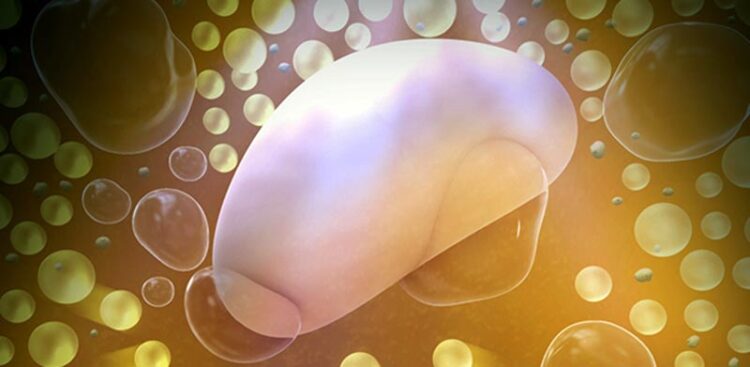Yeast cells cause embedded objects to rise via the microbial Brazil nut effect

Microbial Brazil nut effect artwork
Credit: Srivastava et al.
A phenomenon where microbe-generated gas bubbles create granular fluctuations at the wet sandy floors of rivers, oceans, and lakes has revealed more about the distribution of materials at the bottom of waterbodies.
Tohoku University Researchers dubbed this the “microbial Brazil nut effect.” Details of their research were published in the journal Soft Matter on October 6, 2021.
The Brazil Nut Effect (BNE) happens when a granular mixture subjected to shaking results in bigger particles ending up on top. The name stems from a typical container of mixed nuts, where the larger Brazil nuts inhabit the surface and smaller nuts fall below. BNE has wide-ranging scientific applications, from boulder placement on asteroid surfaces to the pattern formation in early mammalian embryos.
The team set out to test the effects of plastic waste on the ecosystem by mixing silicon rubber into a yeast fermentation vessel. Some microorganisms use cilia and flagella to swim in water. Yeast does not. It rises to the surface at a speed of several centimeters per second by attaching itself to the bubbles it produces during the fermentation process.
Based on the team’s experiments, the artificial material moved up and down from the floor of the vessel to the top, agitating the contents. As a result, nutrients were spread throughout the vessel, promoting further growth of yeast.
The researchers also discovered that microbial fermentation-induced moving transported buried materials one billion times larger than the microorganism itself.
“We successfully visualized and measured the physical phenomenon of soil fluidization and the emergence of buried objects to the water surface due to particle submergence in environments where soil is deposited, such as lake bottoms, river bottoms, and seabeds,” said Kenji Kikuchi, co-author of the study.
The discovery is expected to contribute to the reemergence of dormant microorganisms and viruses in the soil and further our understanding of how unknown pathogens surface.
Journal: Soft Matter
DOI: 10.1039/D1SM01327K
Article Title: Microbial Brazil nut effect
Article Publication Date: 6-Oct-2021
Media Contact
Public Relations
Tohoku University
public_relations@grp.tohoku.ac.jp
All latest news from the category: Earth Sciences
Earth Sciences (also referred to as Geosciences), which deals with basic issues surrounding our planet, plays a vital role in the area of energy and raw materials supply.
Earth Sciences comprises subjects such as geology, geography, geological informatics, paleontology, mineralogy, petrography, crystallography, geophysics, geodesy, glaciology, cartography, photogrammetry, meteorology and seismology, early-warning systems, earthquake research and polar research.
Newest articles

Innovative 3D printed scaffolds offer new hope for bone healing
Researchers at the Institute for Bioengineering of Catalonia have developed novel 3D printed PLA-CaP scaffolds that promote blood vessel formation, ensuring better healing and regeneration of bone tissue. Bone is…

The surprising role of gut infection in Alzheimer’s disease
ASU- and Banner Alzheimer’s Institute-led study implicates link between a common virus and the disease, which travels from the gut to the brain and may be a target for antiviral…

Molecular gardening: New enzymes discovered for protein modification pruning
How deubiquitinases USP53 and USP54 cleave long polyubiquitin chains and how the former is linked to liver disease in children. Deubiquitinases (DUBs) are enzymes used by cells to trim protein…



